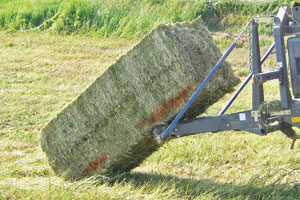Also, a new dye sprayer marking system provides a simple, practical method for visually identifying areas of high-moisture hay in bales.
Over the years, Harvest Tec has led the industry with its automatic preservative application systems that sense hay moisture on-the-go during baling, and continually adjust the amount of preservative being applied.
Now the company has introduced its new 500 Series Automatic Applicator that further improves on Harvest Tec’s process by providing several additional benefits for the hay producer.
For example, the new system allows operators of round balers to calculate baling rate or tonnage, which was previously not possible. For small square balers, a stroke count is now recorded for each bale.
The new 500 Series Automatic Applicator has capabilities for downloading baling records via a USB port. It can store data for up to 300 job records, including individual information on as many as 32,000 bales.
These valuable records can be downloaded to a memory stick and managed in a spreadsheet on an office computer.
The data collected by the new system includes an identifying number for each bale, date and time it was baled, the field, bale weight, average and high moisture of that bale, and the amount of preservative used.
For added convenience, system software updates can be made via the USB port. For the first time, the automatic control system is now available for fixed chamber round balers.
Harvest Tec has introduced a new dye sprayer marking system that applies red food-grade dye to show any sections of high-moisture hay in small or large square bales.
The marking system works hand-in-hand with Harvest Tec’s new 500 Series Application systems. It allows anyone handling the baled hay to visually sort it for feeding or storage purposes, and provides the assurance that wetter bales are easily identified.
The moisture level at which the dye spray is applied can be adjusted anywhere from 8% to 76%. The dye can be set to spray on the top or both sides of the bale. ![]()







